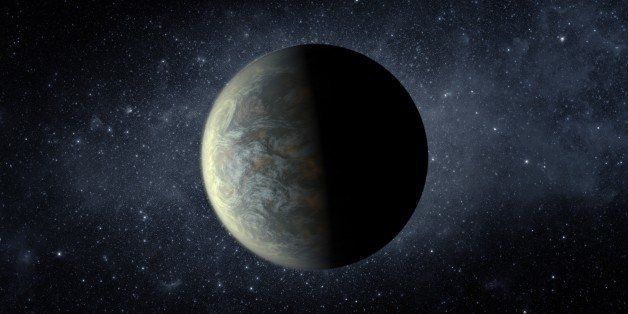
The Kepler Space Observatory was launched on March 7, 2009 with the express purpose of searching for Earth-sized planets. As of November 2013 Kepler had confirmed the detection of 167 planets with another 3,568 candidates awaiting confirmation. On May 11, 2013, the failure of reaction wheels that are used to steer the spacecraft brought the main mission essentially to a close, although other mission possibilities are under consideration.
On November 4, 2013 astronomers from the Universities of California and Hawaii reported on their analysis of the measured brightnesses of 42,000 stars from the Kepler mission. They found 603 planets including ten that were Earth-sized, that is, with radii 1-2 times the Earth radius, that also received comparable levels of stellar energy. That is, the planets orbited in a habitable zone where liquid surface water could exist.
The authors concluded that 22 percent of sun-like stars harbor Earth-size planets orbiting in their habitable zones. Furthermore, they speculate that the nearest such planet may be within 12 light-years.
Seth Shostak, Senior Astronomer of the SETI (Search for Extraterrestrial Intelligence) Institute and HuffPost blogger has crunched the data further. Since stars like the sun make up about 20 percent of the approximately 200 billion stars in the Milky Way, this gives 9 billion planets in our galaxy able to support life. In addition, Shostak refers to another analysis of Kepler data that implies 16 percent of all red dwarf stars sport planets in the habitable zone, thus adding another 24 billion candidates giving a total of perhaps 33 billion habitable worlds within our own galaxy.
Since there are about 150 billion other galaxies in the visible cosmos, this multiplies out to 5,000,000,000,000,000,000,000 planets within the visible universe capable of supporting biological life of some form.
These are just the planets within 46 billion light-years of Earth, which is the horizon beyond which light cannot reach us in the 13.8 billion-year age of the universe. However, beyond that limit exists a far vaster region of space containing a minimum of 23 orders of magnitude as many galaxies as those inside our horizon. (Add 23 zeroes to the above number).
This is not pure speculation. It is based on the empirically well-established theory of cosmic inflation. Also note that I am not talking about other universes here -- just our universe alone.
It is hard to imagine that in all this immensity there aren't countless planets with some form of intelligent life. They are likely to be very different from our own, given the major role of random chance in the evolution of life. But all we know about our kind of life based on carbon chemistry is that it developed very easily once the conditions were right. We also know that the chemicals needed for our kind of life, including amino acids, are very plentiful in space. We just have not found any evidence yet for extraterrestrial life because of the immense distances between stars.
Now, if you were beginning to worry that I was not going to mention God, you can relax. Let's consider the scenario of a Christian God presiding over a universe containing a multitude of intelligent life forms, all created in his image (being unlimited, he has an unlimited number of images) living on other planets.
If Christian teachings are to apply throughout his creation, then you would expect that most of these intelligent life forms would have committed the heinous sin of eating from the Tree of Knowledge and be in need of redemption.
In The Age of Reason, Thomas Paine asked, "Are we to suppose that every world in the boundless creation had an Eve, an apple, a serpent, and a redeemer?" Of course, Paine was unaware how vast this "boundless creation" really is. Jesus must be continually dying on the cross, every nanosecond or so on some planet in the universe, in order to save from eternal damnation every form of life that evolved sufficient intelligence to eat from the Tree of Knowledge.
In the 1930s, astronomer Edward Milne (brother of A. A. Milne, creator of Winnie-the-Pooh) suggested how Jesus could have died just once, here on Earth, and the information of his act of atonement then transmitted by radio to other civilizations. But that would be possible only for intelligent life forms within our horizon. The many more beyond that boundary would necessarily be oblivious of the event. Furthermore, since it will take 46 billion years for the signal to reach every planet in the visible universe, an awful lot of beings will remain unredeemed for a long time.
While I know of no official policy on this question provided by the Catholic Church or any Protestant denomination, the Vatican is not unaware of problem. Speaking unofficially, in 2008 the director of the Vatican Observatory, Fr. José Gabriel Funes, told L'Osservatore Romano, the Vatican newspaper, that there may be other intelligent beings created by God. However, he suggested, "They could have remained in full friendship with the creator." He likened humans to "lost sheep" for which "God became man in Jesus to save us." The other intelligent beings did not necessarily need redemption. (The fact that none have communicated with us yet could indicate that they avoided eating from the Tree of Knowledge and, as a result, never developed radio). According to Funes, "Jesus became man once and for all. The Incarnation is a single and unique event."
So, if Funes is accurately reflecting Catholic thinking, Earthly humans remain the favorite of God -- although a strange kind of favorite who needs redeeming while the countless other intelligent life forms do not.
The Judaic-Christian-Islamic God is a mighty God when viewed from the perspective of the desert tribes in the Middle-East that conceived him. But that God is not mighty enough from the perspective of modern science.